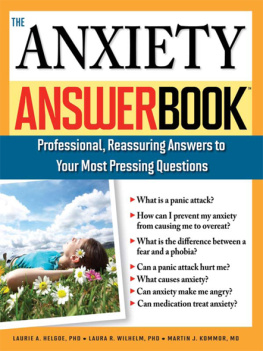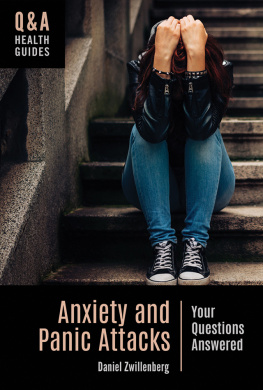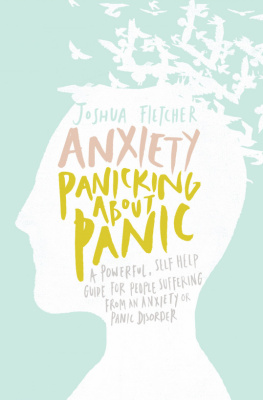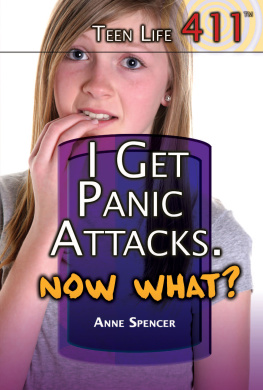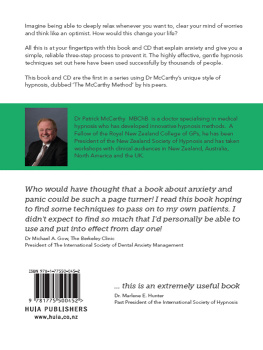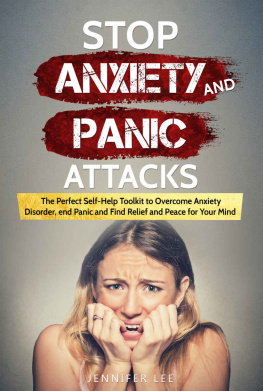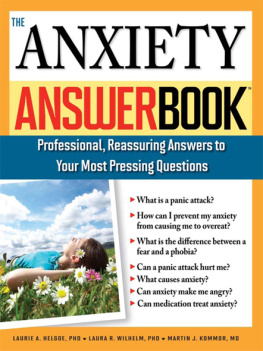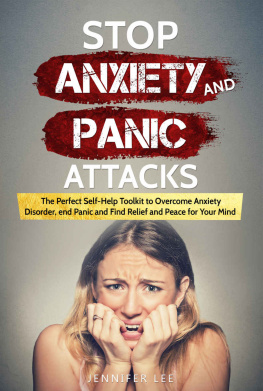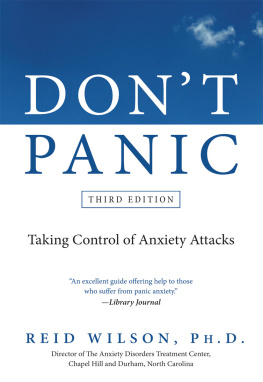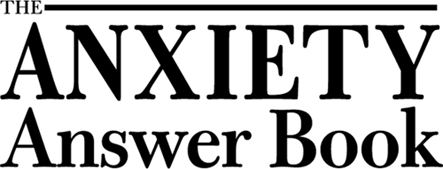
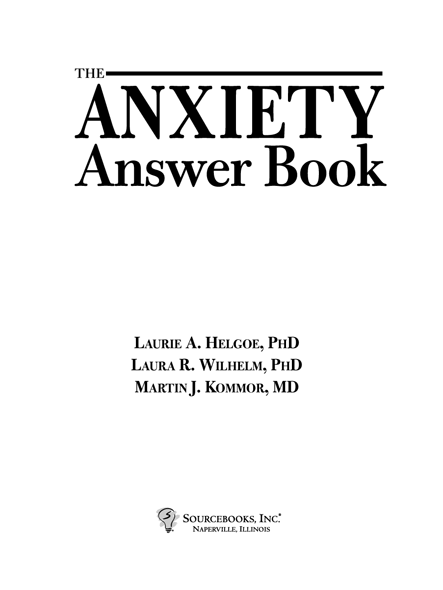
Copyright 2005 by Laurie Helgoe, Laura Wilhelm, and Martin Kommor
Cover and internal design 2005 by Sourcebooks, Inc.
Cover photo Getty Images
Author photo credits: Laurie A. Helgoe: Steve Payne; Laura R. Wilhelm: Rick Lee; Martin J.
Kommor: Lynette Lee
Sourcebooks and the colophon are registered trademarks of Sourcebooks, Inc.
All rights reserved. No part of this book may be reproduced in any form or by any electronic or mechanical means including information storage and retrieval systemsexcept in the case of brief quotations embodied in critical articles or reviewswithout permission in writing from its publisher, Sourcebooks, Inc.
This publication is designed to provide accurate and authoritative information in regard to the subject matter covered. It is sold with the understanding that the publisher is not engaged in rendering legal, accounting, or other professional service. If legal advice or other expert assistance is required, the services of a competent professional person should be soughtFrom a Declaration of Principles Jointly Adopted by a Committee of the American Bar Association and a Committee of Publishers and Associations
This book is not intended as a substitute for medical advice from a qualified physician. The intent of this book is to provide accurate general information in regard to the subject matter covered. If medical advice or other expert help is needed, the services of an appropriate medical professional should be sought.
All brand names and product names used in this book are trademarks, registered trademarks, or trade names of their respective holders. Sourcebooks, Inc., is not associated with any product or vendor in this book.
Published by Sourcebooks, Inc.
P.O. Box 4410, Naperville, Illinois 60567-4410
(630) 961-3900
fax: (630) 961-2168
www.sourcebooks.com
Library of Congress Cataloging-in-Publication Data
Helgoe, Laurie A.
The anxiety answer book / Laurie A. Helgoe, Laura R. Wilhelm, Martin J. Kommor.
p. cm.
Includes bibliographical references and index.
1. Anxiety--Popular works. 2. Anxiety--Treatment--Popular works. 3. Panic attacks-Popular works. I. Wilhelm, Laura R. II. Kommor, Martin J. III. Title.
RC531.H44 2006
616.85'22--dc22
2005012506
Printed and bound in the United States of America.
VP 10 9 8 7 6 5 4 3
For Barron, Bjorn, and Josh, who keep me grounded and help me soar.
L. H.
To my familymy husband Ed, my parents Yvonne and Bob, and my sister and brother-in-law Lisa and Weston. I love you all and feel so blessed to have you in my life. Thank you for everything you have given me.
L.W.
To Ben Kommor, who instructs and inspires me in the tender art of fatherhood.
M. K.
Acknowledgments
Many thanks to our editor, Bethany Brown, for her help, patience, and dedication to quality Gratitude always to Jacky Sach, my agent. And thanks to my friends from The Writer's Villagemy lifeline through the ups and downs of writing. Special thanks to my dear friends, Beth, Mimi, and Cindy, and my sisters, Julie and Becca, for just making life better.
Laurie A. Helgoe
My deepest thanks are extended to the following individuals for their excellent teaching, mentorship, and support: Robert Beck, PhD, Thomas Ellis, PsyD, ABPP, Chris France, PhD, John Linton, PhD, ABPP, and Holly Cloonan, PhD. I also feel very privileged and grateful to have received training at the Albert Ellis Institute and the Beck Institutethe education, staff, fellow trainees, and overall experiences at each of these establishments were amazing. Additional heartfelt thanks to Shannon Froese, PhD, Natalie Shaheen, MD, Liz Moore, MA, Richard Granese, MD, and Esther Stephensonyour friendship always means so much to me, but your help with looking over book drafts was particularly appreciated!
Laura R. Wilhelm
Many thanks to Laurie A. Helgoe, PhD, and Laura R. Wilhelm, PhD.
Martin J. Kommor
Introduction
ANXIETY: THE ALARMING EMOTION
An alarm is sounding in your body. You feel as if danger is at hand, yet no one is chasing you, and no disaster threatens your safety. You may be worrying about something specific, or just feel concerned for no apparent reason. Either way, you know that the alarm is out of proportion with your present situation. Knowing this does not help. You are anxious.
If you suffer from anxiety, or live with someone who does, you are aware of the trouble it can cause. The anxious person feels pressed. It's hard to think clearly. She feels the need to respond, but her responses help only temporarily, if at all. She might feel yelled at from inside. Family members get tired of reassuring her, and she gets tired of trying to explain feelings she may not even understand.
Anxiety is the most common mental health complaint, and all of us have felt in its clutches at some point in our lives. Some anxiety is healthy and necessary to keep us alive; too much anxiety, however, can interfere with living well. Fortunately, we have learned a great deal about anxietyabout what makes it worse and what makes it better. The Anxiety Answer Book pulls this information together in an easy question-and-answer format, providing tools to help you reduce your anxiety and enjoy your life more.
Chapter 1
ANXIETY BASICS
- What is anxiety?
- What causes anxiety?
- What are the different kinds of anxiety disorders?
- How common are anxiety disorders?
- If I have problems with anxiety, does that mean I have a mental illness?
- What are the warning signs that my anxiety needs treatment?
- Can a person be hospitalized for anxiety?
- Do my genes make me more likely to have anxiety?
- Does the way I was raised make me more or less likely to be anxious?
- Will I just grow out of my anxiety if I leave it alone?
- What kinds of anxiety disorders are seen in children?
- Can physical illness or medication produce anxiety-like symptoms?
- How does alcohol affect anxiety?
- How are depression and anxiety related?
- Can anxiety make a person more likely to commit suicide?
- Can some anxiety be healthy?
What is anxiety?
Anxiety is fear without a clear threat. Whereas fear is a natural reaction to an obvious, literal threat to your physical well-being, anxiety often feels abnormal and without use or function. Imagine crossing a street and suddenly a car appears speeding in your direction. You will probably experience the following symptoms of fear:
- Your heart races
- Your breathing increases
- You may perspire
- Your mind focuses
- You are overcome by a sense of urgency to take protective action
These reactions, which happen in a split second, will hopefully spare you from an unpleasant encounter with 3,000 pounds of steel, and leave you grateful for your built-in alarm system. Anxiety, on the other hand, feels more bothersome than helpful. Compare the logic and efficiency of the fear response to these common features of anxiety:
- You may not be able to identify why you're afraid
- If you have a reason, it's not a convincing one (it may be irrational)
- The threat may be distant in the past or future
- The threat could be distant geographically
Next page
